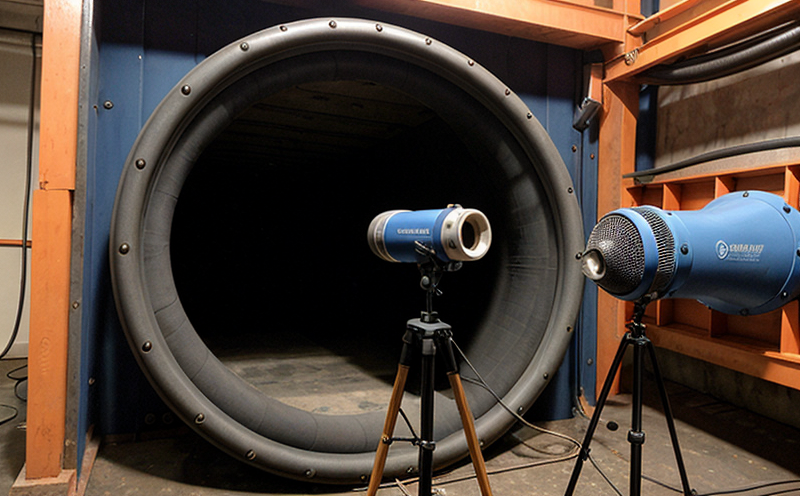ASTM E114 Ultrasonic Pulse-Echo Testing of Welds
The ASTM E114 standard specifies the use of ultrasonic pulse-echo testing to inspect and evaluate welds in metals. This non-destructive testing method provides a means for assessing the internal integrity of welded joints, detecting flaws such as porosity, slag inclusions, and lack of fusion. The technique is widely used across various sectors including aerospace, automotive, manufacturing, construction, and shipbuilding where high reliability and quality standards are paramount.
The ASTM E114 method involves transmitting an ultrasonic pulse into the material using a transducer. The pulse travels through the weld until it encounters an interface or flaw. Upon reflection of this pulse by these interfaces, the signal is received back at the transducer. By measuring the time delay and amplitude changes in the reflected signals, inspectors can determine the location, size, and nature of flaws within the weld.
The ultrasonic testing setup typically includes a water-based coupling agent to ensure efficient transmission of the sound waves from the probe to the surface of the weld. The method is highly sensitive, capable of detecting very small defects that might otherwise go unnoticed. This sensitivity also allows for precise location and sizing of flaws, which is crucial in ensuring structural integrity.
According to ASTM E114, certain parameters must be adhered to ensure accurate testing results. These include the frequency range (typically between 2 MHz and 5 MHz), probe angle selection based on the geometry of the weld, and coupling agent application. Specimen preparation involves cleaning the surface of the weld thoroughly before testing to minimize interference from surface contaminants.
The standard defines acceptance criteria for evaluating test results. Welds that pass this inspection are deemed suitable for service without further intervention. In contrast, welds that exhibit unacceptable flaw characteristics may require rework or rejection. The method is particularly effective in detecting volumetric defects such as voids and cracks within the weld cross-section.
The ASTM E114 method provides a robust framework for ensuring the quality of welded structures. Its non-destructive nature makes it an ideal choice for inspecting critical components where rework or rejection could be costly and time-consuming. By integrating this testing into manufacturing processes, companies can enhance product reliability and safety standards.
Compliance with ASTM E114 is essential in industries that adhere to strict quality control measures. This standard ensures uniformity across different laboratories conducting the test, thereby promoting consistency and comparability of results. It also facilitates regulatory compliance for manufacturers who must meet specific industry or governmental requirements.
In summary, ASTM E114 ultrasonic pulse-echo testing is a versatile and reliable technique that plays a crucial role in ensuring the integrity of welded structures across numerous sectors. Its ability to detect even minute flaws makes it an indispensable tool in quality assurance and compliance programs.
Applied Standards
The ASTM E114 standard is complemented by other relevant standards that provide additional guidance for ultrasonic testing of welds. For instance, ISO 5817 and ASME IX are widely recognized in the industry for their comprehensive approach to welding quality assurance.
- ISO 5817: This standard offers detailed specifications for quality grading based on visual inspection, radiography, and ultrasonic testing. It provides a structured method for assessing welds using these techniques.
- ASME IX: ASME IX is particularly important in the pressure vessel industry as it sets requirements for materials and welding procedures used in construction of vessels and other components subject to high-stress conditions. Ultrasonic testing is one of several non-destructive examination methods specified by this standard.
By incorporating these standards into their quality management systems, organizations can ensure that they are adhering to the highest industry benchmarks for welding integrity and reliability.
Eurolab Advantages
- Comprehensive Expertise: Eurolab boasts a team of experienced professionals with in-depth knowledge of ASTM E114 and other relevant standards. Our personnel are equipped to handle even the most complex testing scenarios.
- State-of-the-Art Facilities: Equipped with advanced ultrasonic testing equipment, our laboratory ensures precise and reliable test results. Our facilities meet all necessary regulatory requirements, providing a secure environment for conducting tests.
- Consistent Quality: Eurolab adheres strictly to ASTM E114 guidelines, ensuring consistent and accurate test results across different projects.
- Comprehensive Reporting: We provide detailed reports that outline the testing process, results, and recommendations. These reports are tailored to meet the needs of various stakeholders including quality managers, compliance officers, R&D engineers, and procurement teams.
Eurolab's commitment to excellence in ultrasonic pulse-echo testing is reflected in our unwavering adherence to industry standards and our robust infrastructure. Our services are designed to support your organization’s quality assurance initiatives, helping you maintain the highest levels of product integrity and reliability.
Use Cases and Application Examples
- Aerospace Industry: In aerospace, ASTM E114 testing is used extensively to inspect critical components such as engine parts and airframe structures. Detecting even minor flaws in these components can prevent catastrophic failures.
- Automotive Sector: This method ensures the quality of welded vehicle frames and other high-stress components. It helps in identifying potential weak points before they lead to accidents or product recalls.
- Manufacturing Industry: For manufacturers producing large-scale industrial equipment, ultrasonic testing is essential for ensuring that all critical welds meet stringent quality standards.
- Construction Sector: In the construction of bridges and other infrastructure projects, ASTM E114 testing ensures that the structural integrity of welded joints meets safety requirements.
- Shipbuilding Industry: Ships require robust welds to withstand harsh marine environments. Ultrasonic pulse-echo testing is used here to inspect hull structures and other critical components for flaws.
- Petrochemical Plants: The integrity of welded pipelines in petrochemical plants is crucial for preventing leaks that could lead to severe accidents or environmental damage.
These examples illustrate the broad applicability of ASTM E114 ultrasonic pulse-echo testing across various industries. Its versatility and reliability make it an indispensable tool in ensuring the quality and safety of welded structures.





